The Relationship between Ethics and Aesthetics in Sustainable Architecture of the Baltic Sea Region
Abstract
1. Introduction
2. Materials and Methods
3. Results
3.1. Defining the Sustainable Architecture
3.2. Aesthetics of Sustainable Architecture
3.3. Environmental Ethics and Aesthetics of Certified Sustainable Buildings in the Baltic Sea Region
4. Discussion and Conclusions
Author Contributions
Funding
Institutional Review Board Statement
Informed Consent Statement
Data Availability Statement
Conflicts of Interest
References
- Lozano, R. Envisioning sustainability three-dimensionally. J. Clean. Prod. 2008, 16, 1838–1846. [Google Scholar] [CrossRef]
- Throsby, D. Economic and Culture; Cambridge University Press: Cambridge, UK, 2001. [Google Scholar]
- Brennan, A.; Lo, Y.S. Environmental Ethics. Stanford Encyclopedia of Philosophy, 2015. Available online: https://plato.stanford.edu/entries/ethics-environmental/ (accessed on 3 September 2020).
- Grant, L.K. Sustainability: From excess to aesthetics. Behav. Soc. Issues 2010, 19, 7–47. [Google Scholar] [CrossRef]
- Hill, G. The Aesthetics of Architectural Consumption. In Aesthetics of Sustainable Architecture; Lee, S., Ed.; 010 Publishers: Rotterdam, The Netherlands, 2011; pp. 26–40. [Google Scholar]
- Kagan, S. Aesthetics of sustainability: A transdisciplinary sensibility for transformative practices. Transdiscipl. J. Eng. Sci. 2011, 2, 65–73. [Google Scholar] [CrossRef] [PubMed]
- Level(s). The European Framework for Sustainable Buildings. 2021. Available online: https://ec.europa.eu/environment/topics/circular-economy/levels_en (accessed on 10 November 2020).
- Fox, W. Introduction. In Ethics and the Built Environment; Fox, W., Ed.; Routledge: London, UK, 2000. [Google Scholar]
- Lee, S. Aesthetics of Sustainable Architecture; 010 Publishers: Rotterdam, The Netherlands, 2011. [Google Scholar]
- Jauslin, D. Landscape aesthetics for sustainable architecture. In Aesthetics of Sustainable Architecture; Lee, S., Ed.; 010 Publishers: Rotterdam, The Netherlands, 2011; pp. 109–119. [Google Scholar]
- United Nations. Sustainable Development Goals. Available online: https://www.un.org/sustainabledevelopment/sustainable-development-goals/ (accessed on 16 October 2020).
- Transforming Our World: The 2030 Agenda for Sustainable Development. 2015. Available online: https://sdgs.un.org/2030agenda (accessed on 20 October 2020).
- Stelbiene, A. Architectural Quality Criteria. A Collection of Scientific Articles. Architecture Objects and Contexts 1; VGTU leidykla Technika: Vilnius, Lithuania, 2015; pp. 28–39. ISSN 2424-3884. eISSN 2424-3892; Available online: http://dspace.vgtu.lt/bitstream/1/1881/3/2330-M_Architekturos_kriterijai_.pdf (accessed on 12 October 2020).
- Energy Performance Certificates. European Commission, 2021. Available online: https://ec.europa.eu/energy/eu-buildings-factsheets-topics-tree/energy-performance-certificates_en (accessed on 5 September 2020).
- Lithuanian Law of Architecture. Vilnius. 2017. Available online: https://e-seimas.lrs.lt/portal/legalAct/lt/TAD/3658622050c911e78869ae36ddd5784f?jfwid=-g0zrz4bb7 (accessed on 3 March 2020).
- Moldavanova, A. Sustainability, aesthetics, and future generations: Towards a dimensional model of the arts’ impact on sustainability. In Transitions to Sustainability: Theoretical Debates for a Changing Planet; Humphreys, D., Stober, S.S., Eds.; Common Ground Publishing: Campaign, IL, USA, 2004; pp. 172–193. [Google Scholar]
- Brown, M.; Haselsteiner, E.; Apró, D.; Kopeva, D.; Luca, E.; Pulkkinen, K.; Vula Rizvanolli, B. (Eds.) Sustainability, Restorative to Regenerative; COST Action CA16114 RESTORE, Working Group One Report: Restorative Sustainability; Urbanity—Architecture, Art, Culture and Communication: Viena, Austria, 2018. [Google Scholar]
- Heymann, D. An Un-Flushable Urinal, Places Journal. June 2012. Available online: https://placesjournal.org/article/an-un-flushable-urinal-the-aesthetic-potential-of-sustainability/ (accessed on 3 March 2020).
- Brook, I. Can ‘Spirit of Place’ be a Guide to Ethical Building? In Ethics and the Built Environment; Fox, W., Ed.; Routledge: London, UK, 2000. [Google Scholar]
- Berardi, U. Sustainability assessment in the construction sector: Rating sys-tems and rated buildings. Sustain. Dev. 2012, 20, 411–424. [Google Scholar] [CrossRef]
- Kamičaitytė-Virbašienė, J.; Gražulevičiūtė-Vileniškė, I. Darnios architektūros genotipas ir fenotipas. Town Plan. Archit. 2011, 35, 82–91. [Google Scholar] [CrossRef]
- Marchand, A.; Walker, S.; De Coninck, P. The role of beauty for sustainability: A discussion on responsible consumption, aesthetics attitudes and product design. WIT Trans. Ecol. Environ. 2006, 99, 371–380. [Google Scholar]
- Musacchio, L.R. The scientific basis for the design of landscape sustainability: A conceptual framework for translational landscape research and practice of designed landscapes and the six Es of landscape sustainability. Landsc. Ecol. 2009, 24, 993–1013. [Google Scholar] [CrossRef]
- Di Carlo, I. The AESTHETICS of Sustainability. Systemic Thinking and Self Organization in the Evolution of Cities. List—Laboratorio Internazionale Editoriale Sas, 2016. Available online: https://www.academia.edu/22793307/The_aesthetics_of_sustainability_systemic_thinking_in_the_evolution_of_cities (accessed on 12 October 2020).
- Guy, S.; Farmer, G. Reinterpreting sustainable architecture: The place of technology. J. Archit. Educ. 2001, 54, 140–147. [Google Scholar] [CrossRef]
- Sauerbruch, M.; Hutton, L. What does sustainability look like? In Aesthetics of Sustainable Architecture; Lee, S., Ed.; 010 Publishers: Rotterdam, The Netherlands, 2011; pp. 41–49. [Google Scholar]
- Wang, P.-C.; Yu, C.-Y. Aesthetic experience as an essential factor to trigger positive environmental consciousness. Sustainability 2018, 10, 1098. [Google Scholar] [CrossRef]
- Kamicaityte-Virbasiene, J.; Grazuleviciute-Vileniske, I. Premises for development of sustainable architecture in urban environment. Town Plan. Archit. 2009, 33, 363. [Google Scholar]
- IB, Conseil International du Bâtiment. Towards Sustainable and Smart-Eco Buildings. Summary Report on the EU-Funded Project Smart-ECO Buildings in the EU, Rotterdam, CIB. 2010. Available online: https://www.irbnet.de/daten/iconda/CIB18098.pdf (accessed on 9 October 2020).
- Sunikka-Blank, M. The concept and aesthetics of sustainable building in Japan. In Aesthetics of Sustainable Architecture; Lee, S., Ed.; 010 Publishers: Rotterdam, The Netherlands, 2011; pp. 186–197. [Google Scholar]
- Knowles, R.L. Solar aesthetic. In Aesthetics of Sustainable Architecture; Lee, S., Ed.; 010 Publishers: Rotterdam, The Netherlands, 2011; pp. 50–65. [Google Scholar]
- Bothwell, K. The architecture of the passively tempered environment. In Aesthetics of Sustainable Architecture; Lee, S., Ed.; 010 Publishers: Rotterdam, The Netherlands, 2011; pp. 66–78. [Google Scholar]
- Finocchicaro, L.; Hestnes, A.G. Symbiosis and Mimesis in the Built Environment. In Aesthetics of Sustainable Architecture; Lee, S., Ed.; 010 Publishers: Rotterdam, The Netherlands, 2011; pp. 259–271. [Google Scholar]
- Meyer, E.K. Sustaining beauty: The performance of appearance: A manifesto in three parts. J. Lands. Archit. 2008, 3, 6–23. [Google Scholar] [CrossRef]
- Attfield, R. Environmental Philosophy and Environmental Ethics for Sustainability; Oxford University Press: Oxford, UK, 2018. [Google Scholar]
- Istiadji, A.D.; Hardiman, G.; Satwiko, P. What is the sustainable method enough for our built environment? IOP Conf. Ser. Earth Environ. Sci. 2018, 213, 012016. [Google Scholar] [CrossRef]
- Delancey, C. Architecture Can Save the World: Building and Environmental Ethics. Philos. Forum. 2004, 35, 147–159. [Google Scholar] [CrossRef]
- International Living Building Institute. Living Building Challenge 4.0.; International Living Building Institute: Seattle, WA, USA, 2019; pp. 64–65. Available online: https://living-future.org/wp-content/uploads/2019/04/Living-Building-Challenge-4.0.pdf (accessed on 11 November 2020).
- DGNB. Overview of the Criteria. Available online: www.dgnb-system.de/en/buildings/new-construction/criteria/ (accessed on 12 October 2020).
- BREEAM. (n.d.) Case Studies. Available online: https://www.breeam.com/case-studies/ (accessed on 5 September 2020).
- Vierra, S. Green Building Standards and Certification Systems. WBDG. 8 May 2019. Available online: www.wbdg.org/resources/green-building-standards-and-certification-systems (accessed on 5 September 2020).
- Souza, E. Evaluating Buildings: 12 Green Building Certifications to Know. ArchDaily. 27 August 2020. Available online: https://www.archdaily.com/946290/evaluating-buildings-12-green-building-certifications-to-know> (accessed on 15 November 2020).
- USGBC. Projects. Available online: https://www.usgbc.org/projects (accessed on 14 October 2020).
- DGNB System. Projects. Available online: https://www.dgnb-system.de/en/projects/ (accessed on 15 October 2020).
- Pintos, P.; Powerhouse Brattørkaia/Snøhetta. Archdaily. 2019. Available online: https://www.archdaily.com/924325/powerhouse-brattorkaia-snohetta (accessed on 8 September 2020).
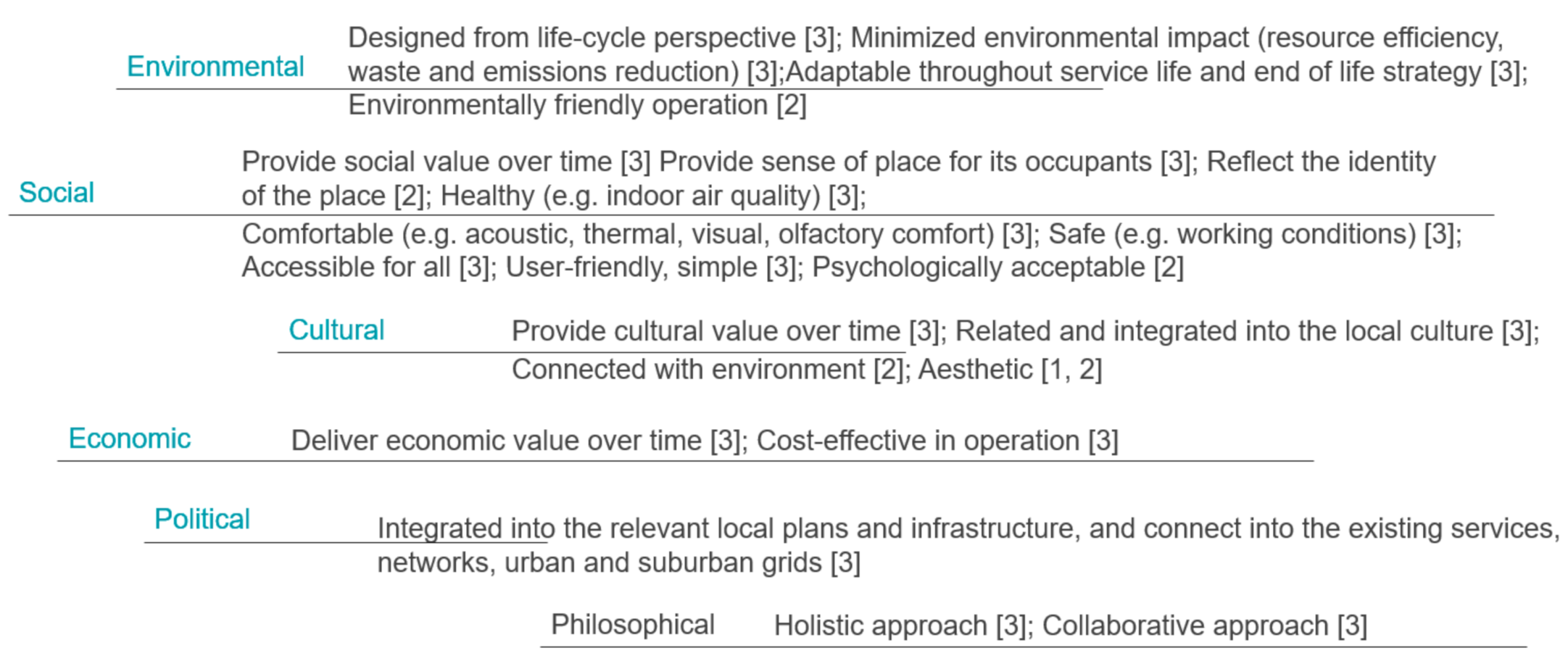
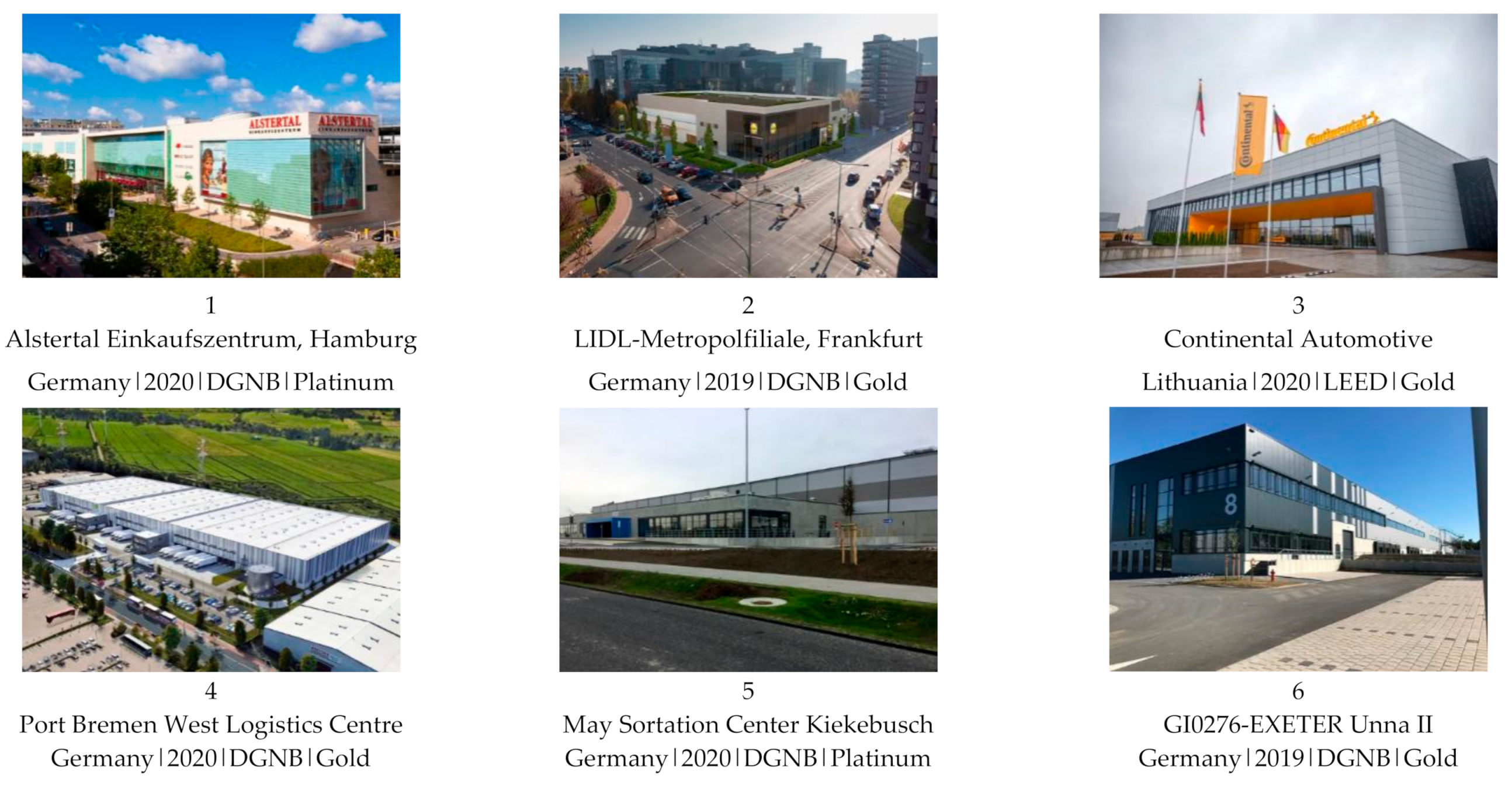
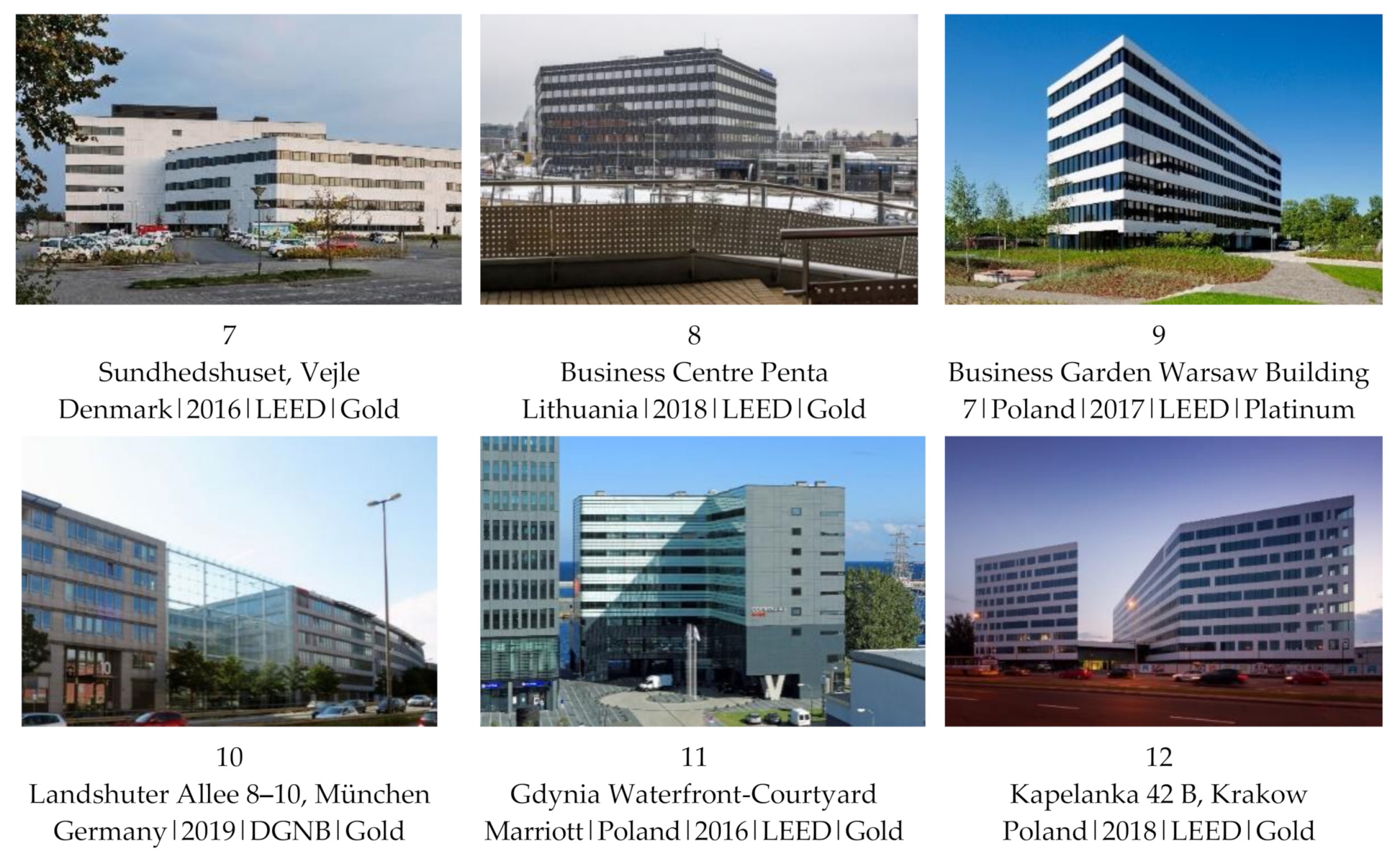
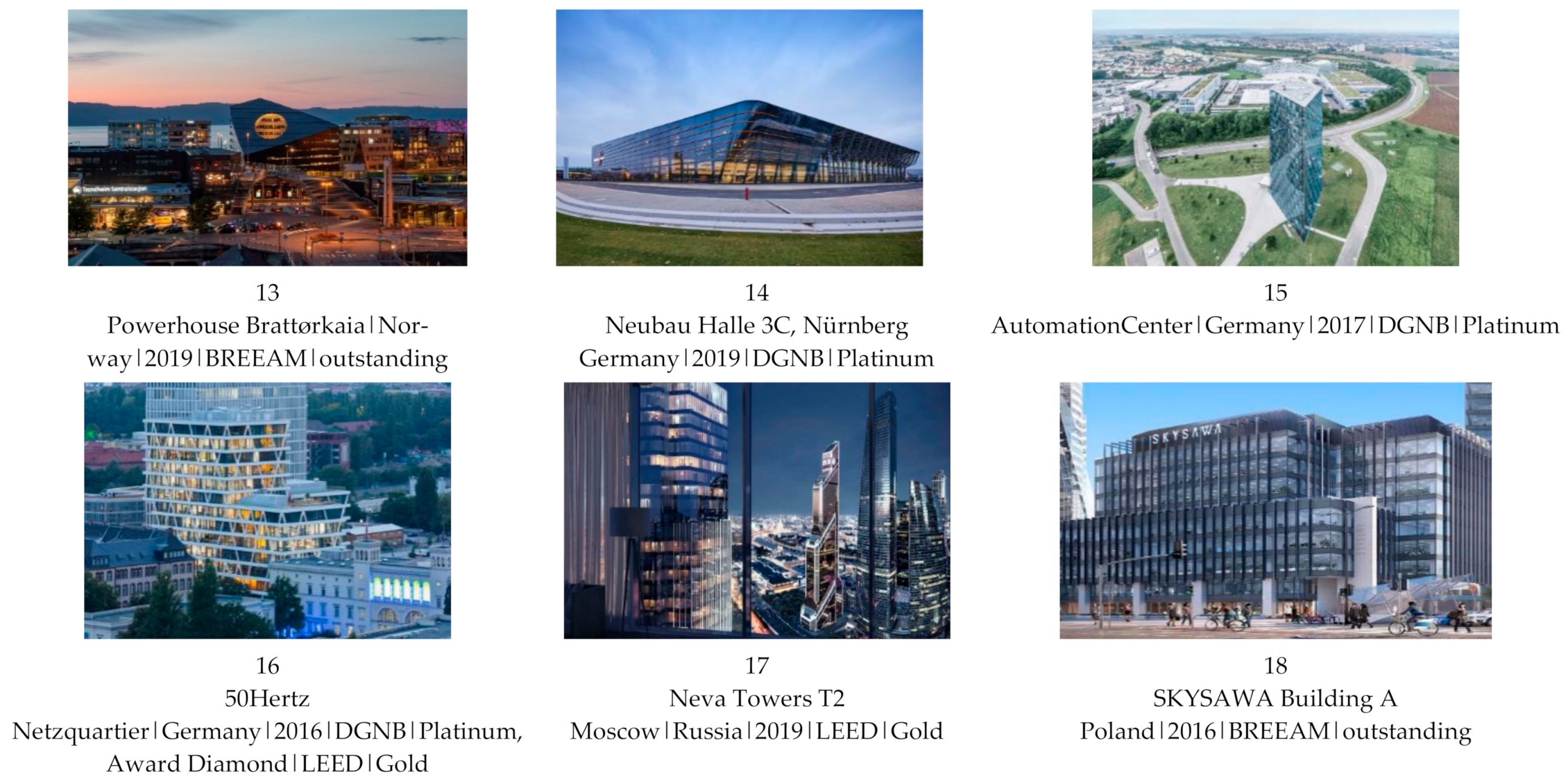
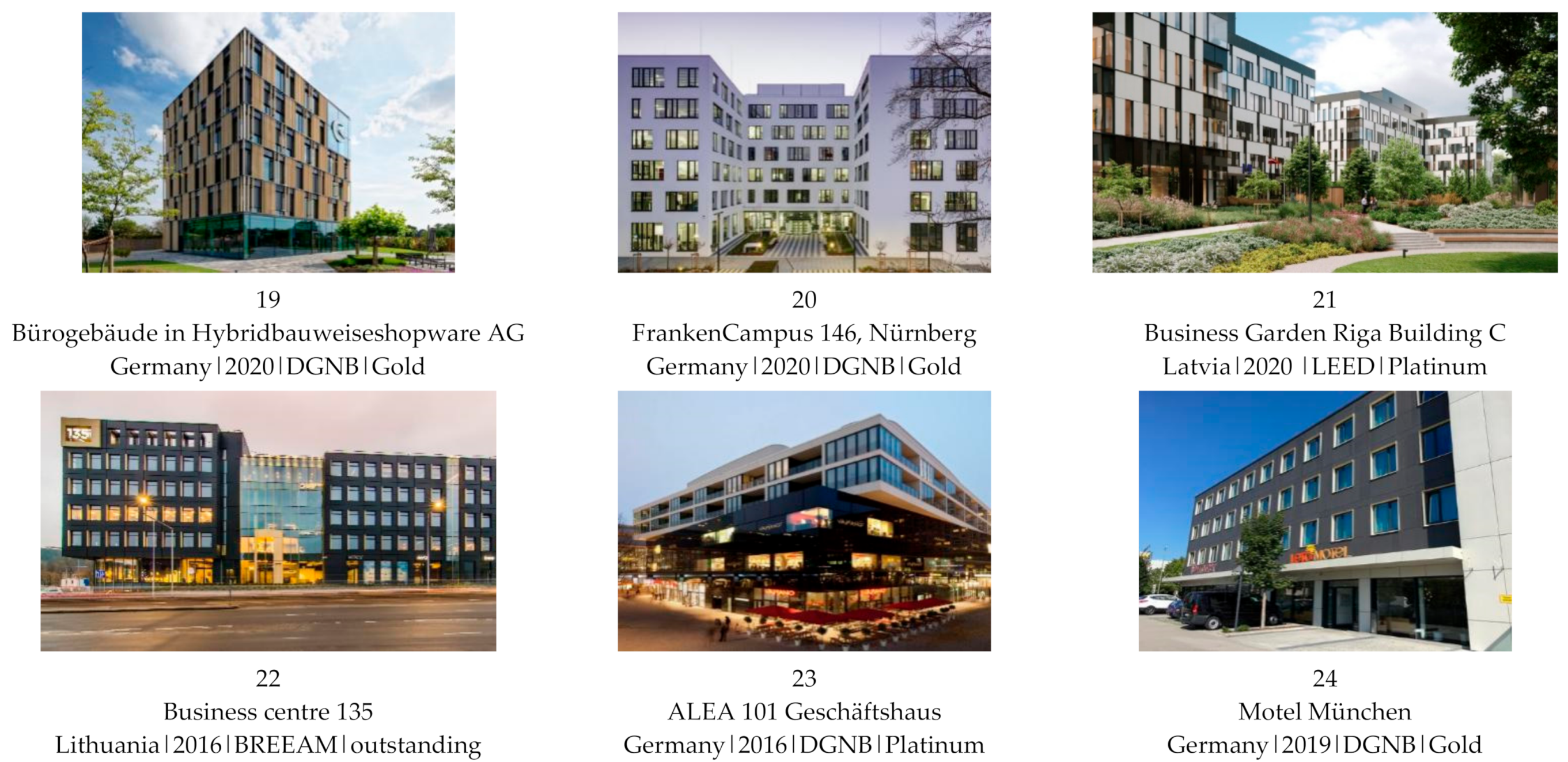
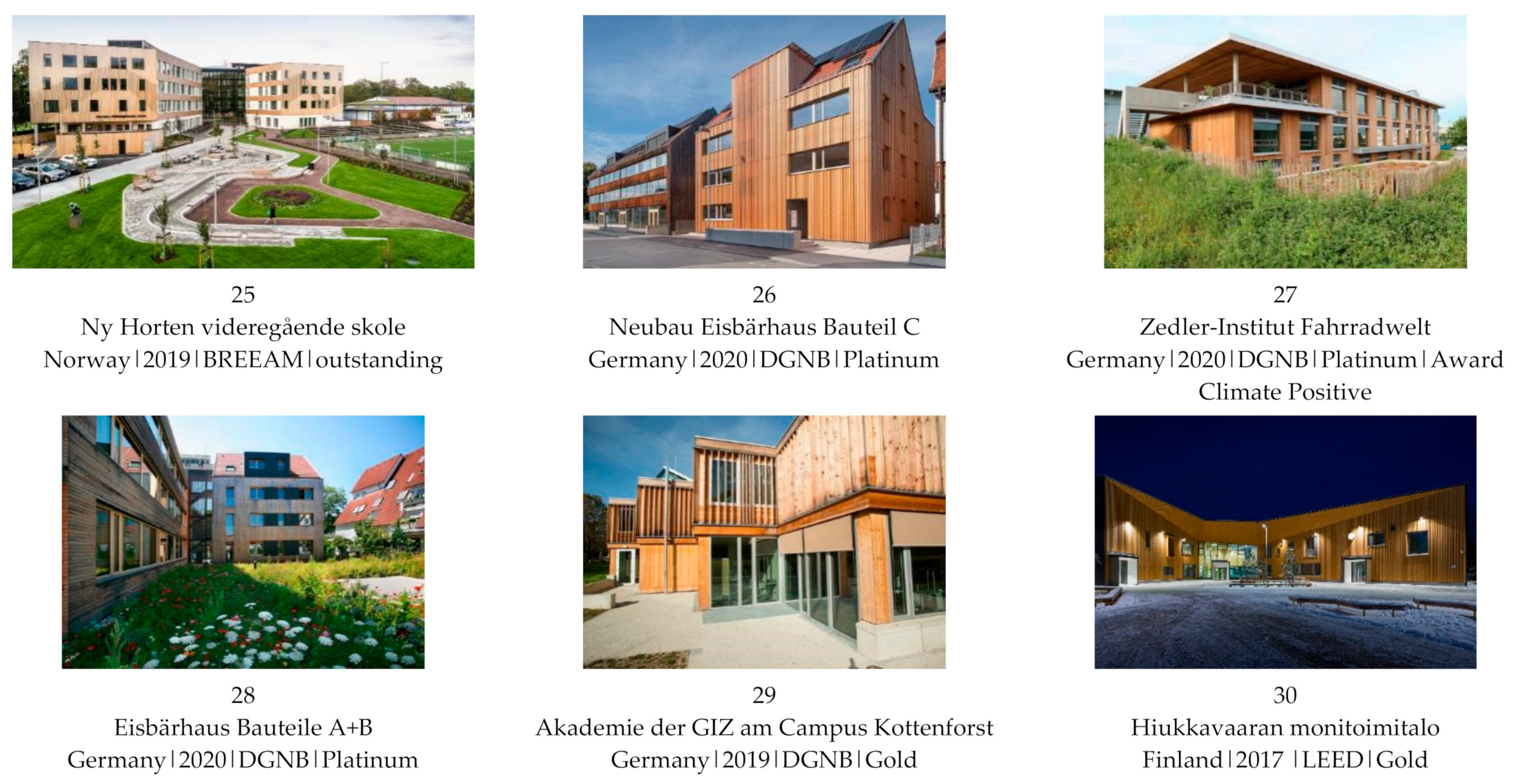

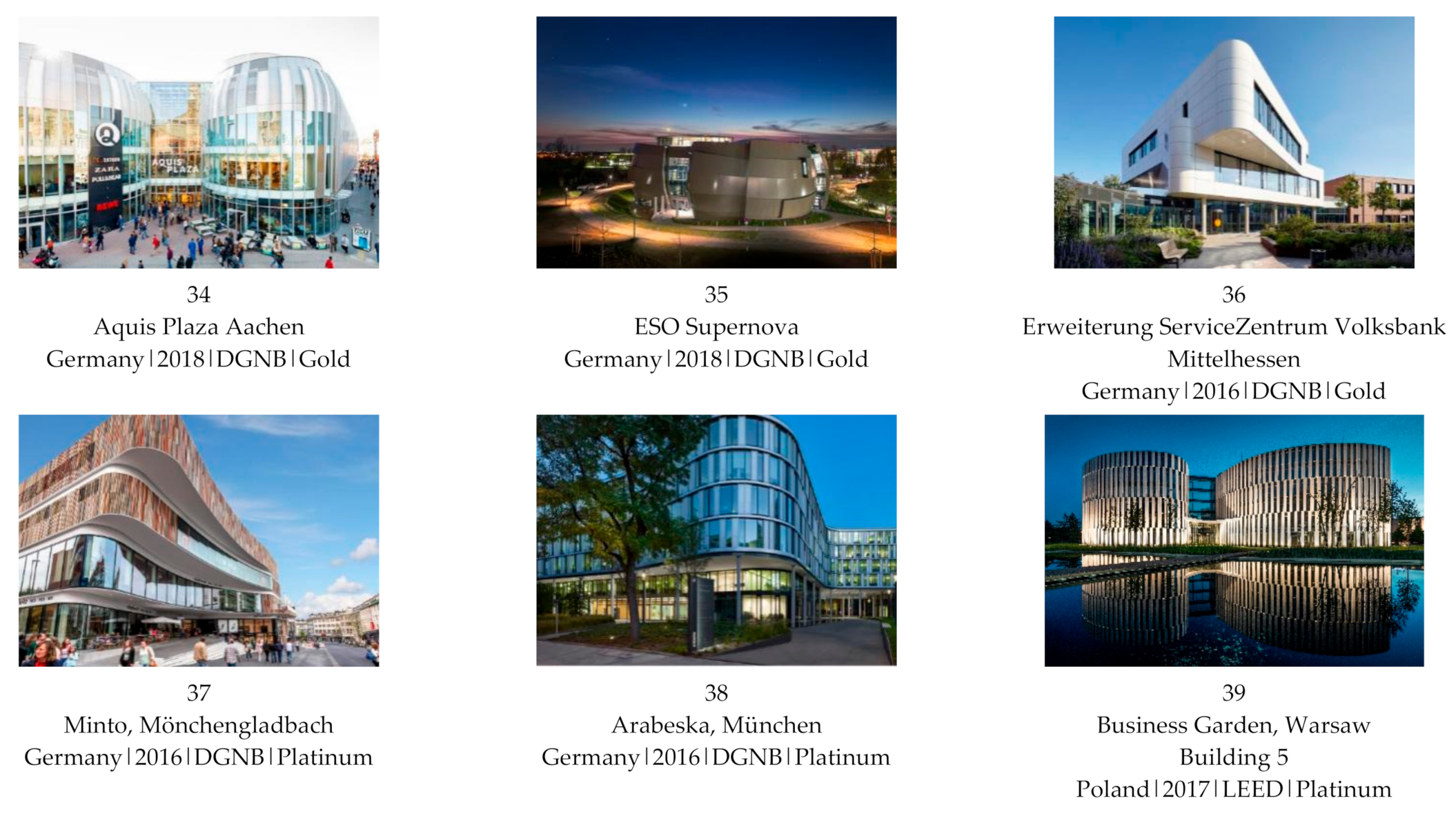
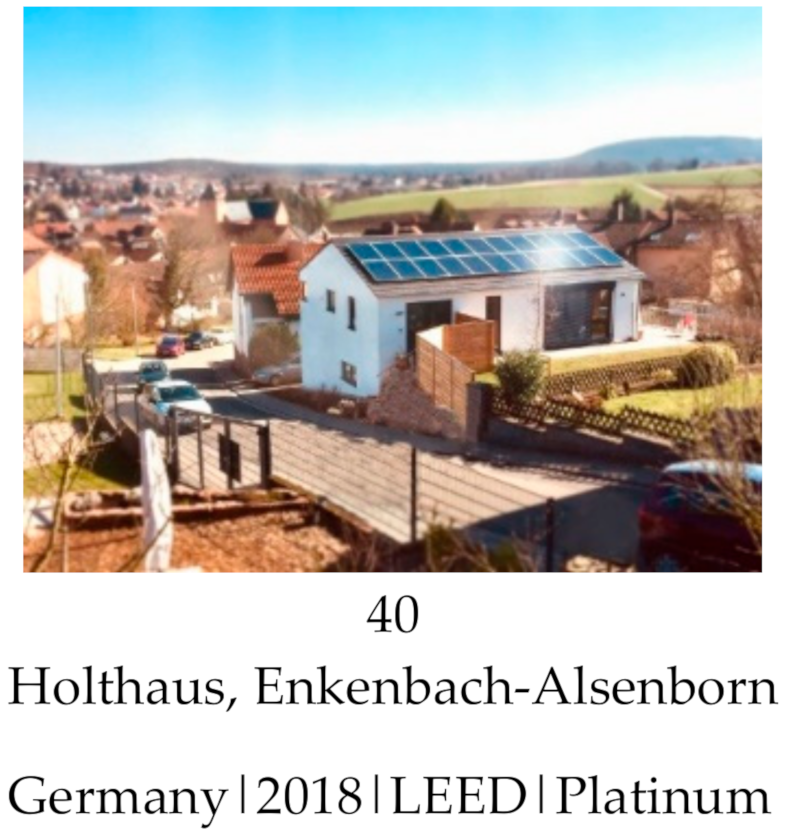
| No. | Certification System | Origins | Focused on | Certificate Rating (Highest-Lowest) |
|---|---|---|---|---|
| 1 | BREEAM (Building Research Establishment Environmental Assessment Method) | United Kingdom 1990 | energy, health and wellness, innovation, use of the soil, materials, management, pollution, land use and ecology, transport and waste | Outstanding Excellent Very good Good Pass Acceptable |
| 2 | LEED (Leadership in Energy and Environmental Design) | USA 1998 | location and transport, sustainable sites, efficiency of water use, energy and atmosphere, materials and resources, internal environmental quality, innovation and processes, regional priority credits | Platinum Gold Silver |
| 3 | DGNB (Deutsche Gesellschaft für Nachhaltiges Bauen) | Germany 2007 | holistic approach, life cycle, sociocultural and functional, environmental, economic, site, technical and process quality assessment | Platinum Gold Silver Bronze |
Publisher’s Note: MDPI stays neutral with regard to jurisdictional claims in published maps and institutional affiliations. |
© 2021 by the authors. Licensee MDPI, Basel, Switzerland. This article is an open access article distributed under the terms and conditions of the Creative Commons Attribution (CC BY) license (http://creativecommons.org/licenses/by/4.0/).
Share and Cite
Daugelaite, A.; Grazuleviciute-Vileniske, I. The Relationship between Ethics and Aesthetics in Sustainable Architecture of the Baltic Sea Region. Sustainability 2021, 13, 2259. https://doi.org/10.3390/su13042259
Daugelaite A, Grazuleviciute-Vileniske I. The Relationship between Ethics and Aesthetics in Sustainable Architecture of the Baltic Sea Region. Sustainability. 2021; 13(4):2259. https://doi.org/10.3390/su13042259
Chicago/Turabian StyleDaugelaite, Aurelija, and Indre Grazuleviciute-Vileniske. 2021. "The Relationship between Ethics and Aesthetics in Sustainable Architecture of the Baltic Sea Region" Sustainability 13, no. 4: 2259. https://doi.org/10.3390/su13042259
APA StyleDaugelaite, A., & Grazuleviciute-Vileniske, I. (2021). The Relationship between Ethics and Aesthetics in Sustainable Architecture of the Baltic Sea Region. Sustainability, 13(4), 2259. https://doi.org/10.3390/su13042259






